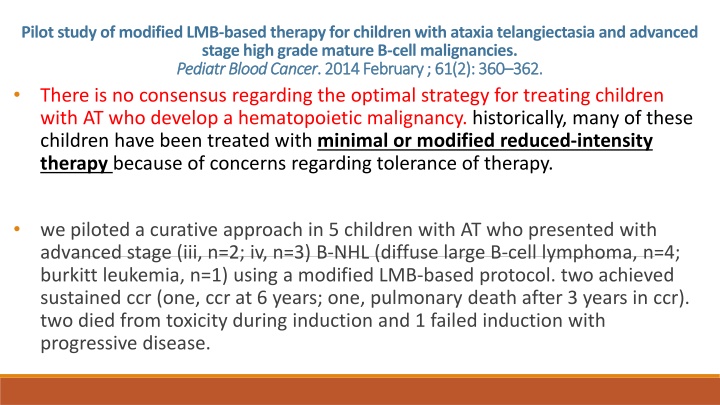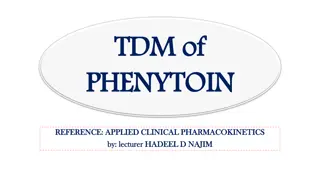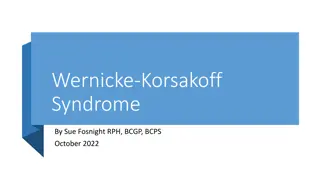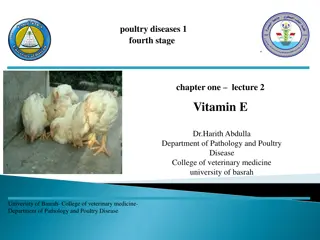
Modified LMB-Based Therapy for Ataxia Telangiectasia
Explore the use of modified LMB-based therapy in children with advanced-stage high-grade B-cell malignancies associated with ataxia telangiectasia. The study presents outcomes, challenges, and considerations in treating these complex cases. Learn about the pilot study's results and implications for future treatment strategies.
Download Presentation

Please find below an Image/Link to download the presentation.
The content on the website is provided AS IS for your information and personal use only. It may not be sold, licensed, or shared on other websites without obtaining consent from the author. If you encounter any issues during the download, it is possible that the publisher has removed the file from their server.
You are allowed to download the files provided on this website for personal or commercial use, subject to the condition that they are used lawfully. All files are the property of their respective owners.
The content on the website is provided AS IS for your information and personal use only. It may not be sold, licensed, or shared on other websites without obtaining consent from the author.
E N D
Presentation Transcript
Pilot study of modified LMB-based therapy for children with ataxia telangiectasia and advanced stage high grade mature B-cell malignancies. Pediatr PediatrBlood Cancer Blood Cancer. 2014 February ; 61(2): 360 . 2014 February ; 61(2): 360 362. There is no consensus regarding the optimal strategy for treating children with AT who develop a hematopoietic malignancy. historically, many of these children have been treated with minimal or modified reduced-intensity therapy because of concerns regarding tolerance of therapy. 362. we piloted a curative approach in 5 children with AT who presented with advanced stage (iii, n=2; iv, n=3) B-NHL (diffuse large B-cell lymphoma, n=4; burkitt leukemia, n=1) using a modified LMB-based protocol. two achieved sustained ccr (one, ccr at 6 years; one, pulmonary death after 3 years in ccr). two died from toxicity during induction and 1 failed induction with progressive disease.
Ataxia-telangiectasia and T-Cell Leukemias: No Evidence for Somatic ATM Mutation in Sporadic T-ALL or for Hypermethylationof the ATM-NPAT/E14 Bidirectional Promoter in T-PLL1. Cancer Research 58 Cancer Research 58, 2293 , 2293- -2297, June I. 1998) 2297, June I. 1998) A-T3 is a recessive pleiotropic syndrome caused by mutations in the ATM gene (1, 2) located at 1Iq22-q23 (3). The risk of malignancies, especially lymphoid neoplasias of T-cell origin, is substantially increased in A-T and was associated previously with spontaneous chromosomal instability observed in A-T. T-PLL, an aggressive malignancy with a median age at diagnosis of 69 years, exhibits immunophenotypic and cytogenetic similarities to a T-cell leukemia seen in A-T . In particular, T-PLL is often associated with translocations and inversions of chromosome 14
Pediatr hematol oncol 1998 Sep-Oct;15(5):425-9. Ataxia telangiectasia associated with B-cell lymphoma: the effect of a half-dose of the drugs administered according to the acute lymphoblastic leukemia standard risk protocol. Because of increased chemosensitivity, the treatment of AT patients with malignancies requires extremely careful planning and caution with respect to the use of chemotherapy. The authors report on a 12-year-old boy with AT who developed B-cell lymphoma. He received a half-dose of the drugs administered according to the acute lymphoblastic leukemia (ALL) protocol issued by our children's cancer study group (9104 Standard Risk Protocol, Tokai Pediatric Oncology Study Group). As a result, he continues to be in complete remission and free of treatment complications 32 months after the diagnosis of B-cell lymphoma.
J clin immunol2016 Oct;36(7):667-76. Lymphoma Secondary to Congenital and Acquired Immunodeficiency Syndromes at a Turkish Pediatric Oncology Center. We summarized the clinical characteristics and treatment results of 17 cases with primary immunodeficiency that developed non-Hodgkin lymphoma (NHL) and Hodgkin lymphoma (HL). 7 patients were diagnosed with AT, two with CVID, two with selective IgA deficiency, one with XLP syndrome, one with Wiskott-Aldrich syndrome, one with EBV related lymphoproliferative syndrome, one with interleukin-2- inducible T-cell kinase (ITK) deficiency, and one with lymphoma developing after ALPS. 7 were diagnosed with HL and 10 with NHL (seven B-cell, three T-cell). The NHL patients were started on the BFM, POG9317, LMB-96, or R-CHOP treatment protocols with reduced chemotherapy dosages. HL cases were started on ABVD and/or COPP protocol, also with modified dosages. six of the ten NHL patients have died. Primary immunodeficiency is a strong predisposing factor for developing lymphoma.
Annals of Oncology Annals of Oncology 11 Non Non- -Hodgkin's Hodgkin's lymphoma in pediatric patients with chromosomal lymphoma in pediatric patients with chromosomal breakage syndromes syndromes (AT and NBS): Experience from the BFM trials (AT and NBS): Experience from the BFM trials 11 ( (Suppl Suppl I): I): S141 S141- -S145, 2000. S145, 2000. breakage In three consecutive multicenter therapy, trials for pediatric NHL (NHL-BFM), 1569 patients with newly diagnosed NHL have been registered between 1986 and 1997. Nine patients with AT (n = 5) and NBS (n = 4) were identified. Results: Median age of patients with AT and NBS at diagnosis of NHL was nine years. Diffuse large B-cell lymphoma, n = 1 ; ALCL, n = 1; lymphoblastic T-cell lymphoma, n = 1 Stages were: I and II in 3 patients, III in 5 and IV in 1 patient. All patients received polychemotherapy according to tumor-entity and stage, none received radiation. Dose reductions according to individual tolerance concerned mainly ethotrexate, alkylating agents and epipodophyllotoxines.
Annals of Oncology Annals of Oncology 11 Non Non- -Hodgkin's lymphoma in pediatric patients with chromosomal breakage syndromes (AT and Hodgkin's lymphoma in pediatric patients with chromosomal breakage syndromes (AT and NBS): Experience from the BFM trials NBS): Experience from the BFM trials 11 ( (Suppl Suppl I): I): S141 S141- -S145, 2000. S145, 2000. From April 1986 to October 1997, 1569 patients up to 18 years of age with newly diagnosed NHL or B-ALL were registered in the NHL-BFM study center. Among these 1569 patients, 9 patients were suffering from AT or NBS. These patients were analyzed regarding clinicopathological features,treatment modalities and outcome.
Annals of Oncology Annals of Oncology 11 Non Non- -Hodgkin's lymphoma in pediatric patients with chromosomal breakage syndromes (AT and Hodgkin's lymphoma in pediatric patients with chromosomal breakage syndromes (AT and NBS): Experience from the BFM trials NBS): Experience from the BFM trials 11 ( (Suppl Suppl I): I): S141 S141- -S145, 2000. S145, 2000. Therapy and response criteria Patients with lymphoblastic T-cell lymphoma received ALL type therapy consisting of induction, consolidation, re-induction, and maintenance therapy as previously described . Patients with B-cell lymphoma or anaplastic large-cell lymphoma of either immunophenotype received four to six courses of polychemotherapy as described elsewhere. Intensity and duration of therapy was stratified according to stage at diagnosis and to initial tumor mass, determined by serum-concentration of lactate dehydrogenase (LDH). In patients with AT or NBS, the study-center recommended to start therapy with reduced intensity depending on the physical state of the patient, history of previous infections and other ID-related complications . Therapy was intensified during following courses according to tolerance of the first course
T-cell Acute Lymphoblastic Leukemia in a Child With Ataxia-telangiectasia- Case Report
Modified chopchemotherapy plus rituximab for diffuse large Modified chop chemotherapy plus rituximab for diffuse large B cell complicating ataxia telangiectasia complicating ataxia telangiectasia B cell lymphoma lymphoma Chemotherapy was considered and, in order to avoid the severe complications reported in patients with AT treated for cancer (Abadir & Hakamin, 1983), a modified dosage of CHOP was chosen. mg/m2, doxorubicin 15 mg/m2, vincristine 1 mg/m2on d The patient received: cyclophosphamide 300 1, prednisone 40 mg/m2/d for 5 d. This treatment was repeated every 3 Rituximab at a dosage of 375 weeks for eight cycles. On d mg/m2was made. 2 of each cycle, the addition of






















